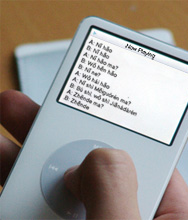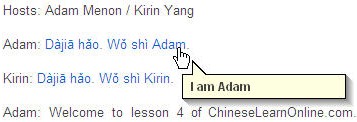Learn Mandarin Chinese
Progressive self study course for absolute beginners to intermediate learners

Progressive self study course for absolute beginners to intermediate learners

There are over 400 lessons to choose from. Absolute beginners should start at lesson 1. Each lesson continues where the last one left off.

Later lessons use the Chinese that was taught in earlier lessons. This way you are constantly reusing and remembering what was taught.

Premium subscribers get access to exercises, games and flashcard activities to reinforce what was taught.

Sign up with your Facebook account to try out the first 4 lessons of the course for free.
There are many ways to teach languages and everyone has their own opinions on what works best for them. Based on my experience learning Chinese though, the following are the methods that worked best for me and which will be used on this website. By combining several of these methods into one strategy, I'm confident that this system will easily accomodate any learning style.

I've noticed many other learning Chinese systems get right into teaching complex phrases or having you memorize long word lists right from day one. I don't believe in this - our goal is to make learning the language easy not long and strenuous. Each lesson only introduces a few words at a time. Each new word is broken down for you and explained to help you remember it. Old vocabulary is constantly being reused. You will quickly start learning Chinese without even knowing it!


iPODS and MP3 players represent the ultimate teaching tools. You can easily set up your computer to automatically download the latest lesson to your portable player each time you plug it in. This way, while traveling to work or whenever it's convenient, you can listen to the latest lesson at your leisure without taking any additional time out of your busy life. The lessons are kept short - under fifteen minutes in length to keep your attention. This also allows easy review of past lessons. Detailed premium transcripts can be printed out from your computer and taken with you to practice on the go. Additionally, lesson transcripts are linked with the audio files so listeners can view transcripts right on the screen of your portable player. Turn your MP3 player into the ultimate teaching tool!

One aspect that is lacking from most teaching systems is a level of interaction between the teacher and the student. Unless you’re paying for a one on one tutor or are in a small class, there is little chance of you actually being able to test whether you understand the material being presented. We try to make our lessons interactive by encouraging listeners to sound out new vocabulary as it is introduced and by asking questions that require listeners to respond. The correct answer is immediately provided to allow listeners to check their level of understanding. For those not able to sound out words out aloud while listening, we still suggest that you do so in your head as this still helps improve your pronunciation.

 Lot of the other teaching systems I looked at just taught random lessons that weren’t linked together. While they were great at teaching situational dialogues, a lot of the vocabulary was forgotten soon after because it wasn’t used in other lessons. We do things differently here by building upon the vocabulary learned in previous lessons. By constantly reusing it, it will less easily be forgotten. Anytime it becomes too advanced, listeners can easily go back to previous lessons to review vocabulary to get them back on track. Our Course Outline on this website show what vocabulary is taught in each lesson and Premium detailed transcripts allow users to refer to which lesson each word was originally introduced in. This also allows more advanced users to comfortably hop in and continue without having to start listening from the beginning. Review questions are also placed in select Premium lesson notes to encourage you to review previously learned material.
Lot of the other teaching systems I looked at just taught random lessons that weren’t linked together. While they were great at teaching situational dialogues, a lot of the vocabulary was forgotten soon after because it wasn’t used in other lessons. We do things differently here by building upon the vocabulary learned in previous lessons. By constantly reusing it, it will less easily be forgotten. Anytime it becomes too advanced, listeners can easily go back to previous lessons to review vocabulary to get them back on track. Our Course Outline on this website show what vocabulary is taught in each lesson and Premium detailed transcripts allow users to refer to which lesson each word was originally introduced in. This also allows more advanced users to comfortably hop in and continue without having to start listening from the beginning. Review questions are also placed in select Premium lesson notes to encourage you to review previously learned material.

This course has been designed purposely to use three of your senses in learning. It is scientifically proven that the more senses you use in a situation, the easier it is to remember it. The course starts with listening - listen to the lessons in each podcast. Each line of dialogue is read slowly and time is given for you to repeat it and practice your speaking. Lesson summaries include all the characters in English pinyin to allow you to visualise what is being taught to better aid in retention. Using these senses together in this manner allow you to learn and retain what is being taught in a much more effective manner than other systems that only use one or two of the above methods.

 The best thing about learning through this system is that you get to learn exactly the way YOU want to. Want to slow things down? Go right ahead - listen to the lessons on your own schedule. Review them as many times as you need to. Want to pick up the pace? Go right on ahead - listen to as many lessons in a row as you'd like. We provide you with numerous language tips along the way but there is no one there to dictate what you must do and when it needs to be done - you choose what to do and when you'd like to.Now that you know the philosophy behind our system, here are the specific approaches we take towards teaching the main components of the Chinese language.
The best thing about learning through this system is that you get to learn exactly the way YOU want to. Want to slow things down? Go right ahead - listen to the lessons on your own schedule. Review them as many times as you need to. Want to pick up the pace? Go right on ahead - listen to as many lessons in a row as you'd like. We provide you with numerous language tips along the way but there is no one there to dictate what you must do and when it needs to be done - you choose what to do and when you'd like to.Now that you know the philosophy behind our system, here are the specific approaches we take towards teaching the main components of the Chinese language.
Pronunciation - Chinese uses a lot of tones and syllables that we native English speakers are not accustomed to. The best way to learn them therefore is to mimic native Chinese speakers. There will be lots of opportunity to do so as pauses are introduced for you to repeat after the speaker. As well you will hear the voice of myself, a non native Chinese speaker also speaking Chinese giving you another representation of how the language might sound.
Grammar / Syntax - We don't go heavy into the rules and syntax here since we find them well...plain boring. There are plenty of places you can go to if you're interested in that. However it is important, so we teach it to you by having you use the language as much as possible. You can take note of rules as you go by but don't worry too much if you don't understand them since you'll slowly get the hang of it with more practice.
Vocabulary - Sorry but we don't use long lists of vocabulary that you have to memorize. When a new word comes along, we teach it to you. If it shows up enough times you'll remember it. We teach you enough basics to "get by". The rest of the vocabulary acquisition will come after knowing these basics. As well, from time to time we'll also introduce the breakdown in how words and expressions are formed in Chinese. So rather than just teaching you how to say "hello", we'll also tell you that the breakdown of hello is "you good". This helps in remembering it as well as understanding and practicing how such words are used in Chinese.
Language Culture - knowing a language isn't good enough - you have to know how and when to use it. The Chinese culture is very different from the western culture in many aspects. Things that we do and take for granted out in the west can be quite taboo in China and vice versa. Our premium lesson notes point out these situations to best equip you with the skills needed to succeed.
Idioms - Where possible we include the most commonly used idioms in our dialogue. For example, if you asked someone how they were doing and they replied with "horse, horse, tiger, tiger" would you know what they meant?
Written language - the main focus for this course is on speaking and listening. However we think reading and language are also important. While we don't focus on teaching them, our premium lesson notes do include transcripts in both traditional and simplified Chinese characters.
I hope that covers everything regards how we go about doing things on this website. For comments and feedback on the above, please Contact Us.